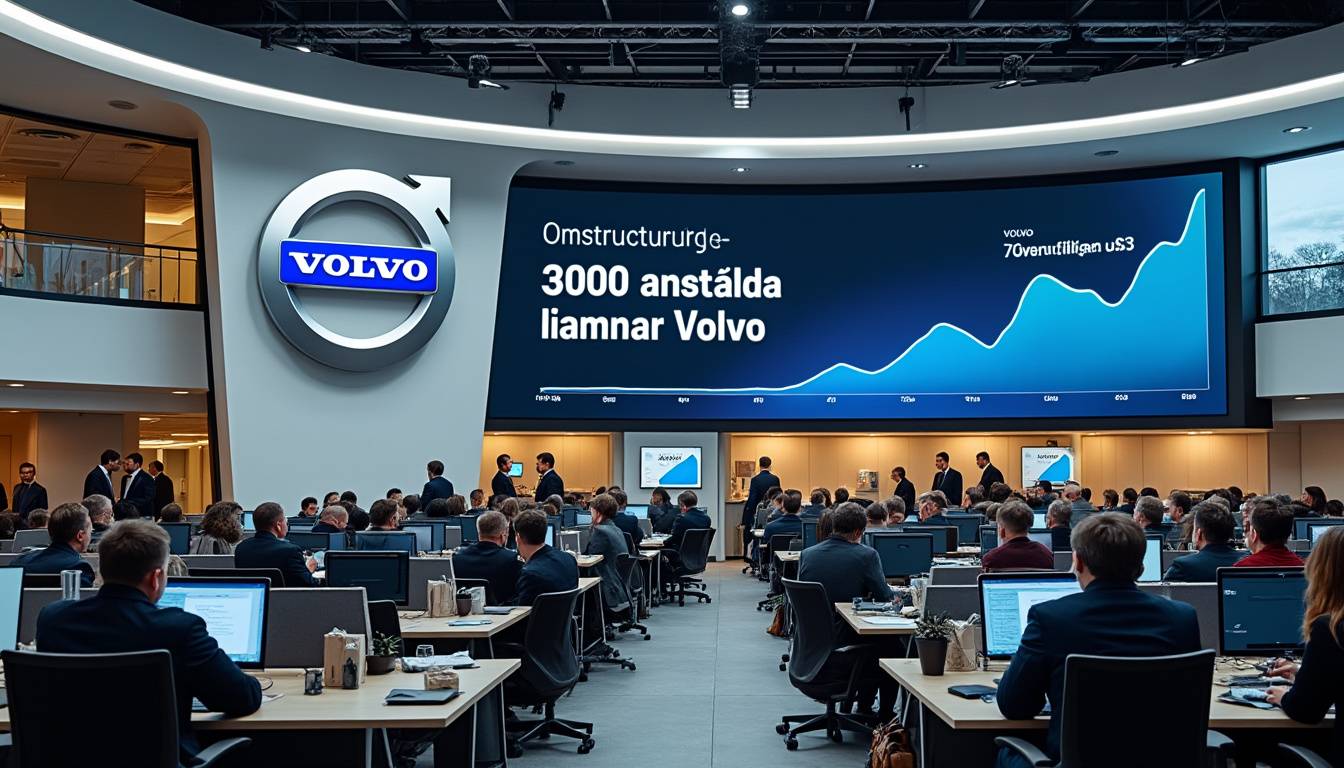The global automotive sector is witnessing a definitive shakeup as Volvo Cars, the renowned Swedish manufacturer, moves to reduce its workforce by about 3,000 positions worldwide. This decisive cost-cutting step reflects broader economic and geopolitical pressures currently reshaping the industry landscape. Trade tensions, market uncertainties, and fluctuating demand challenge legacy automakers to adjust their strategies, seeking efficiency without sacrificing innovation and competitive edge. Against a backdrop where rivals such as Ford, BMW, Mercedes-Benz, Toyota, and Nissan navigate similar headwinds, Volvo’s announcement underscores how carmakers are prioritizing structural cost management in a turbulent environment.
This article dissects Volvo Cars’ strategic workforce downsizing while contextualizing it within the automotive sector’s ongoing challenges. Key themes explored include global trade disruptions, regional impacts of job cuts, corporate strategy shifts, competitor responses, and the future outlook for automakers embracing leaner operations.
- Volvo Cars’ global workforce reduction strategy and cost-cutting objectives
- Trade tensions and economic uncertainties shaping the automotive industry
- Impact of job eliminations primarily in Sweden and other key markets
- Comparative outlook: How major carmakers like Ford, Audi, and Porsche respond to market volatility
- Long-term implications for Volvo and industry-wide structural shifts in workforce management
Volvo Cars’ Workforce Reduction Strategy Amid Industry Pressures
In 2025, Volvo Cars announced a significant plan to eliminate approximately 3,000 jobs worldwide, amounting to roughly 7% of its total global employees. This move primarily targets office-based roles, signaling a strategic trimming of non-manufacturing functions to bolster the company’s resilience amid volatile market conditions. With a workforce totaling 42,600 employees, this restructuring effort reflects a robust cost management paradigm tailored to enhance cash flow and maintain profitability in challenging times.
Sweden, the core of Volvo’s operations, will bear a substantial share of the impact: around 1,200 jobs are slated for elimination, including many consultant roles currently pivotal to operations. This decision underscores a pivotal reshaping of Volvo’s organizational footprint in its home country, where the headquarters and primary product development offices reside.
Volvo’s president and CEO, Håkan Samuelsson, emphasized the gravity and necessity of these steps. He acknowledged that such decisions are difficult but essential to building a “stronger and even more resilient Volvo Cars.” These words reflect an acute awareness of the automotive industry’s shifting dynamics, driven by cost pressures and a need for structural efficiency.
Rationale Behind Targeting Office Positions
The focus on reducing office-based jobs is not unique to Volvo. Across the automotive industry, administrative, marketing, and planning roles are scrutinized for potential optimization. This aligns with an industry-wide trend toward digital transformation, where automation and artificial intelligence reduce the need for human intervention in routine tasks.
- Automation of administrative workflows
- Enhanced digital customer engagement platforms reducing traditional marketing roles
- Consolidation of project management functions with cross-functional teams
By reallocating resources from overhead to innovation-centric activities, Volvo aims to keep pace with competitors such as Mercedes-Benz and Audi, who have also adopted leaner office operations while investing heavily in electric vehicle (EV) research and autonomous driving technologies.
| Category | Estimated Job Reductions | Location | Focus Area |
|---|---|---|---|
| Office Employees | 1,800 | Global | Administrative, Planning, Marketing |
| Consultants | 1,000 | Primarily Sweden | Advisory and Specialist Roles |
| Manufacturing & Assembly | 200 | International Sites | Production-line Adjustments |
This table highlights Volvo’s approach to streamline across multiple layers, with a predominant concentration on office-based roles. Notably, the 200 jobs affected in manufacturing reflect local adaptations to production demands rather than wholesale factory shutdowns.
These cost-cutting measures come amid rising raw material prices and intensified trade restrictions. For instance, US tariffs on steel and imported vehicles weigh heavily on European manufacturers, including Sweden-based Volvo. Such external pressures diminish margins and compel strategic adjustments, as corroborated by industry-wide data and insider insights.
Trade Tensions and Economic Uncertainty Impacting the Automotive Sector
The recent global trade environment exerts enormous strain on automotive manufacturers, a pressure cooker for decision-makers at firms like Volvo, Toyota, and Volkswagen. The imposition of 25% tariffs on steel and imported vehicles by the United States has disrupted supply chains and inflated input costs, catalyzing the retrenchment strategies seen across the sector.
Trade disputes particularly hit European and Asian automakers, whose products compete for market share in North America. The result is diminished volume forecasts and tighter profitability, compelling companies to revisit labor and cost structures. Volvo’s decision dovetails with these sectoral responses to an increasingly complex economic backdrop.
Underlying Causes of Economic Uncertainty in the Auto Industry
- Raw material price volatility, especially steel and aluminum
- Global supply chain disruptions post-pandemic and geopolitical tensions
- Softening demand across mature markets, notably Europe
- Shift toward environmentally friendly vehicles demanding heavy R&D investments
Such macroeconomic factors converge to erode the traditional profitability of combustion vehicle segments. Giants like Honda, Nissan, and Porsche, while advancing EV technologies, also face margin compression necessitating operational efficiencies.
Global car sales trends reflect these challenges. Europe’s car market remains muted due to consumer caution and regulatory changes, while China, a key growth driver, presents competitive complexities and evolving consumer preferences that pressure companies’ cost bases and strategic options.
| Region | 2025 Projected Car Sales (Millions) | Year-on-Year Growth (%) | Key Challenges |
|---|---|---|---|
| Europe | 14.5 | -3.2% | Regulatory changes, economic slowdown |
| North America | 17.8 | -1.5% | Tariffs, shifting consumer preferences |
| China | 35.1 | 1.1% | Competitive market, high EV adoption |
These sales figures outline the constrained environment under which firms like Volvo operate, especially within their European stronghold. Against this backdrop, cutting operational costs is indispensable to retain competitiveness and business viability.
Trade tensions and uncertainties have ripple effects extending well beyond production costs. Delays in component shipping, fluctuating tariffs, and inconsistent policies pose risks to investment and strategic expansion plans, further prompting companies to tighten internal operations.
Regional and Operational Impact of Volvo’s Job Cuts
Volvo’s restructuring plan predominantly affects Sweden, with secondary impacts distributed internationally. The targeted elimination of approximately 1,200 Swedish-based employees, alongside cuts to around 1,000 consultants in the same region, highlights the company’s focus on consolidating its homefront operations amid global pressures.
Outside Sweden, reductions at facilities in Belgium, South Carolina, and China, although smaller in number, represent an alignment with localized market realities. For example, production in South Carolina adjusts to demand fluctuations in the North American market, while Chinese operations remain essential for penetrating Asia’s EV landscape.
Implications for the Swedish Workforce and Regional Economy
The concentration of job cuts in Sweden has multifaceted implications. The country, proud of its automotive heritage linked to Volvo, faces a temporary disruption in employment, with potential ripple effects on local suppliers and service sectors connected to the company. The Swedish government and industry experts track these developments closely, balancing the need for economic sustainability with social welfare concerns.
- Impact on high-skilled professionals in product development and corporate functions
- Potential re-skilling and redeployment programs to mitigate unemployment effects
- Government support initiatives to foster innovation and alternative employment
Volvo’s decision to cut consulting positions also signals a move to internalize expertise or reduce dependency on costly external advisors, a common trend across major corporations in these economically cautious times.
| Region | Workforce Reduction Approximate Scale | Affected Sectors | Long-Term Strategy |
|---|---|---|---|
| Sweden | 2,200 (Including Consultants) | Corporate Headquarters, R&D | Streamlining operations, internal skill development |
| Belgium | 400 | Manufacturing Plant | Production efficiency improvements |
| South Carolina | 300 | Assembly Line, Regional Headquarters | Aligning production with market demand |
| China | 100 | Manufacturing and Market Support | Market penetration and EV focus |
Volvo’s recalibration stresses retaining a global footprint while optimizing headcount and operational efficiency according to regional market conditions. This nuanced approach balances global ambitions with pragmatic cost controls.
Comparing Cost-Cutting Strategies in Major Automotive Competitors
Volvo’s workforce reduction is part of a broader trend among leading carmakers facing similar challenges. Names like Ford, BMW, Mercedes-Benz, Toyota, Honda, Nissan, Audi, Porsche, and Volkswagen have all enacted or plan measures to manage costs, navigate tariff challenges, and shift toward electric and autonomous vehicles efficiently.
For instance, Ford recently announced restructuring efforts focused on reducing salaried staff globally, while BMW is pursuing lean production and digitalization strategies. Mercedes-Benz continues investing in technology but has implemented cuts in administrative divisions. Toyota and Honda emphasize hybrid technology while cautiously trimming back legacy combustion projects.
Sector-Wide Considerations in Workforce Adjustments
- Balancing innovation investment with cost controls
- Shifting to electric vehicle platforms and reducing legacy production roles
- Adapting workforce skills to new technology demands
- Regional market considerations and tariff impacts
Compared against these peers, Volvo’s decision to cut about 7% of employees fits into the median range of workforce reshaping. This signals realistic measures rather than drastic overhauls, reflecting measured pragmatism.
| Manufacturer | Recent Workforce Reduction Announcement | Focus Areas | Market Challenges |
|---|---|---|---|
| Volvo | 3,000 jobs cut globally (~7%) | Office roles, consultants, selective manufacturing | Trade tensions, raw material costs, European market decline |
| Ford | 5,000 salaried staff reduction | Global administration, restructuring | Global supply chain, electrification costs |
| BMW | 4,000 staff reduction planned | Lean production, digital transformation | EU emissions regulations, EV competition |
| Mercedes-Benz | 3,200 administrative cuts | Administrative and sales divisions | Tariffs, luxury market softening |
| Toyota | 1,500 job cuts | Combustion engine tech reduction | Hybrid transition, Asian market shifts |
These data portray the uniform pressures facing the automotive industry, where companies balance cost containment with the imperative to innovate for a cleaner, more automated future.
Long-Term Industry Trends and the Future Outlook for Automotive Workforce Management
Volvo’s recent decision to streamline operations signals broader trends that will shape automotive employment and industry structure moving forward. Cost pressures, the electrification transition, and geopolitical friction converge to redefine how companies allocate human capital and invest in technology.
Strategically, Volvo and several competitors are pivoting toward leaner, more agile organizations. The workforce is becoming increasingly specialized, focusing on areas like software development, battery technology, and autonomous vehicle systems. Traditional roles are diminishing, reflecting the shifts in consumer demand and regulatory landscapes.
Emerging Trends in Automotive Workforce Dynamics
- Increased reliance on software and AI experts for vehicle tech
- Outsourcing of non-core functions and consultancy reductions
- Reskilling of workforce toward EV and autonomous vehicle skills
- Greater regional flexibility in workforce deployment to match market needs
On a broader scale, this realignment also affects industry suppliers and aftermarket services, triggering a ripple effect on employment beyond the carmakers themselves. These changes dovetail with evolving personal finance trends in 2025, highlighting growing importance of adaptability and lifelong learning in career prospects.
| Trend | Description | Implication for Workforce |
|---|---|---|
| Digital Transformation | Shift from manual to automated processes in manufacturing and management | Demand for tech-savvy employees and fewer traditional roles |
| Electrification | Transition from combustion engines to electric powertrains | Increased R&D jobs vs. reduced mechanical roles |
| Globalized Supply Chains | Complex sourcing and manufacturing networks | Needs flexible workforce models and contingency planning |
| Cost Efficiency | Structural cost cutting to maintain profitability and competitiveness | Job reductions in non-core areas and operational streamlining |
The competitive landscape in 2025 is shaped not only by current pressures but also by strategic investments centered on innovation and sustainability. Companies that align their workforce and cost structures effectively are best positioned to navigate the future.
Exploring personal finance trends reveals how economic conditions influence workforce and industry decisions, framing these employment changes within a wider societal context. For further insights, explore related analyses on wealth management and innovations in global trade finance.

